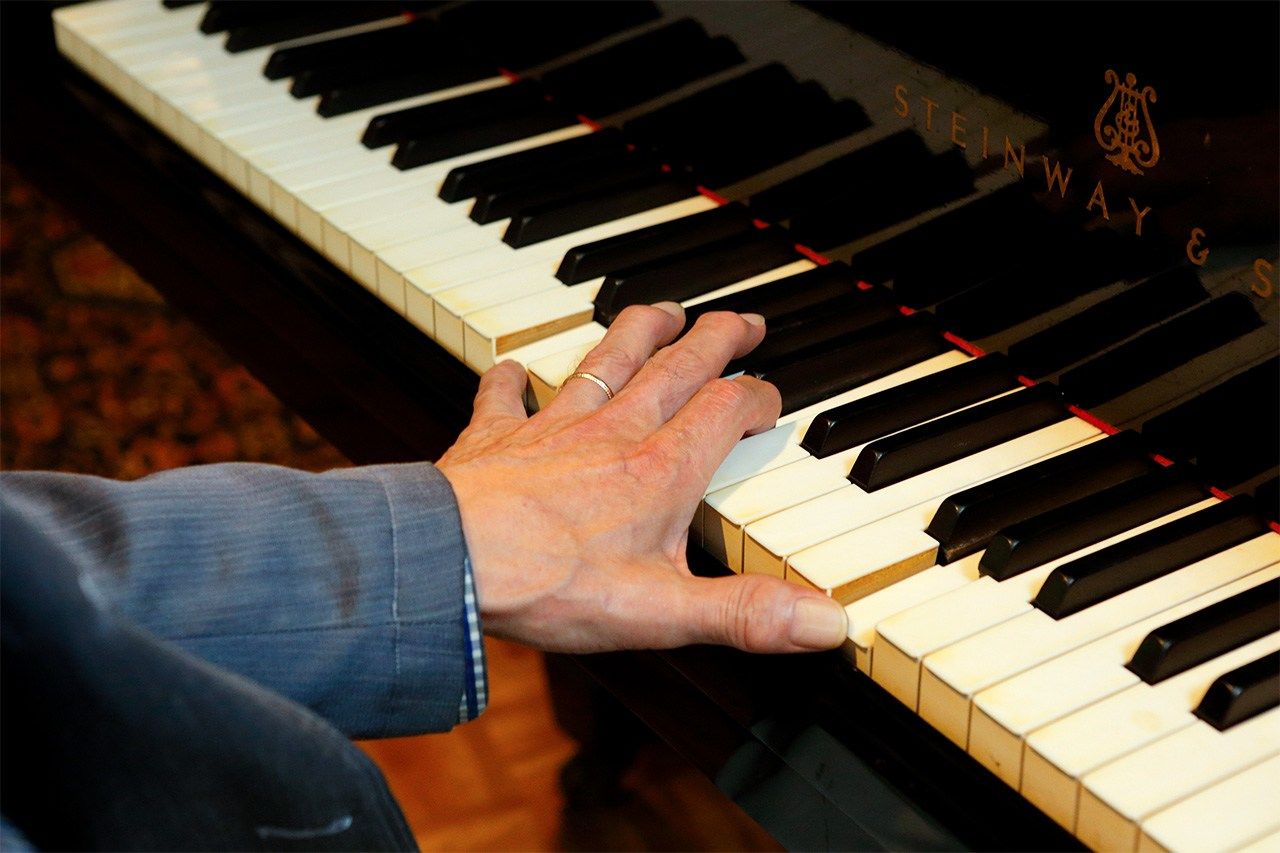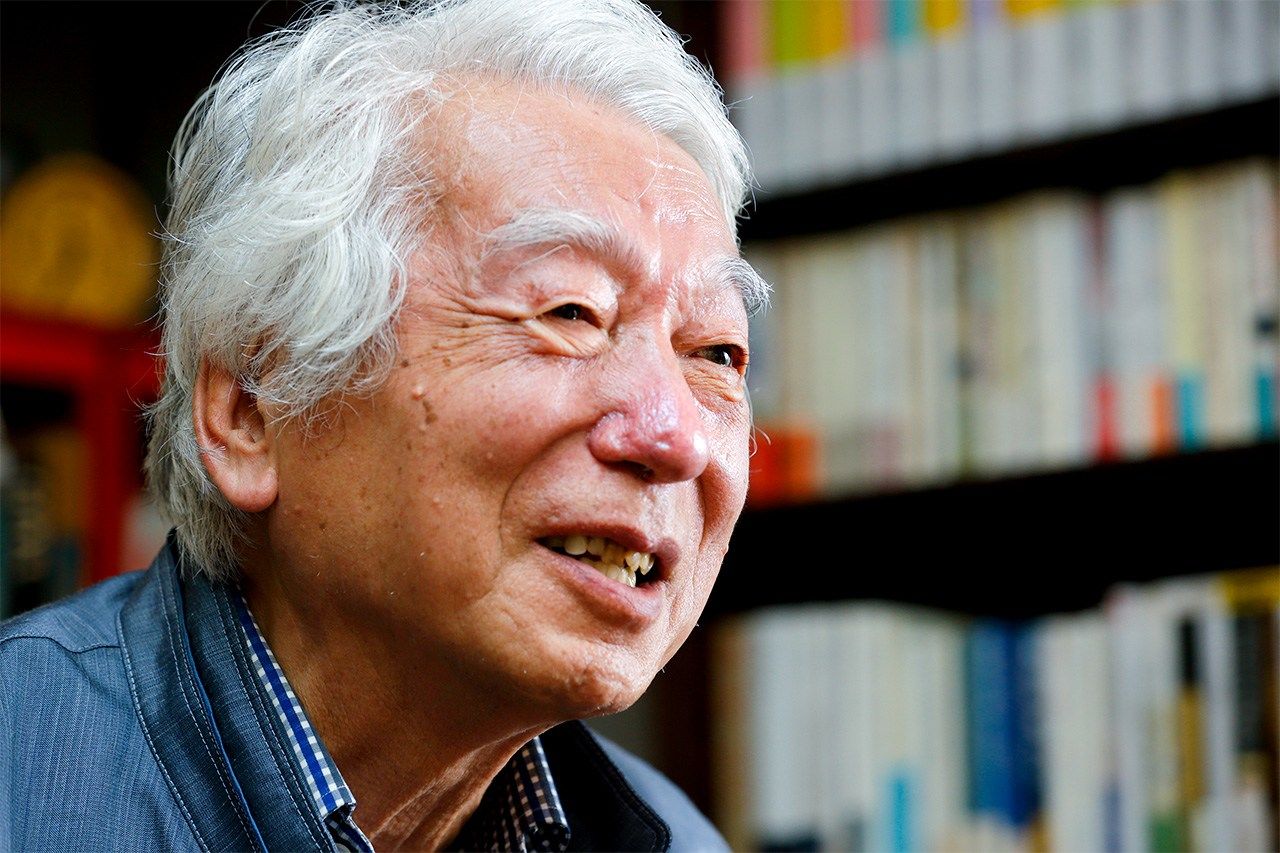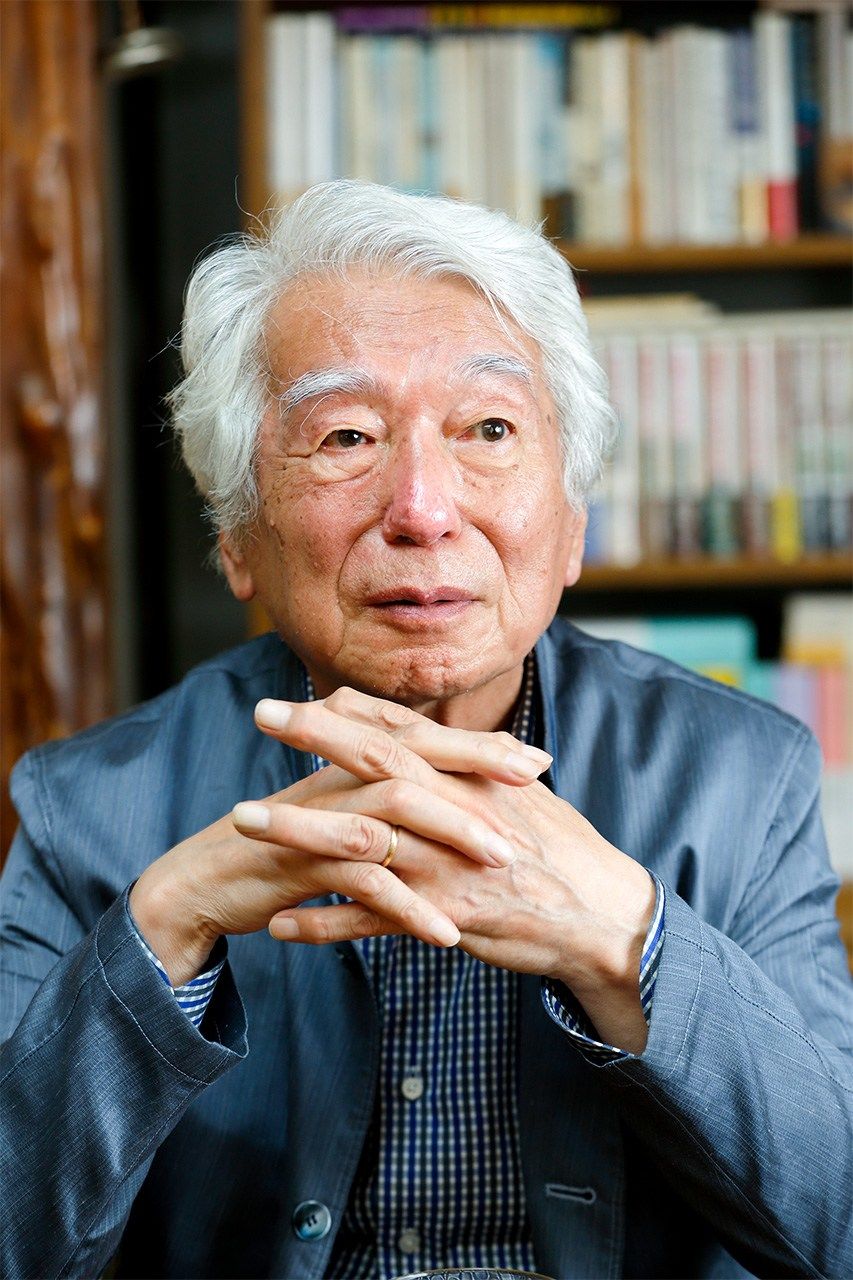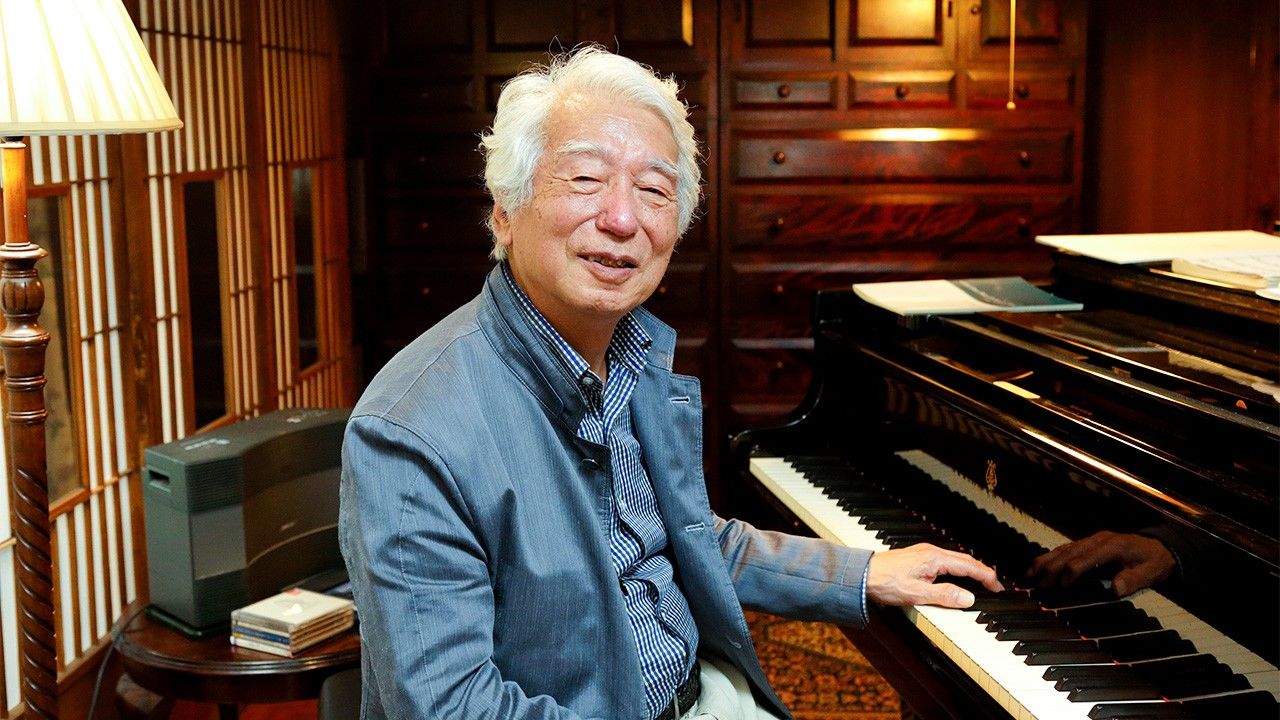
Pianist Tateno Izumi: One Hand, No Limits
Music Culture Art- English
- 日本語
- 简体字
- 繁體字
- Français
- Español
- العربية
- Русский
Powerful yet delicate, clear and transparent yet rich and complex, Tateno Izumi’s one-handed piano playing captivates listeners above all with the depth and range of its lyrical expression.
Tateno sums it up simply: “I use this hand to make music, and through the music I express what’s in my own heart.”
Tateno settled in Finland in 1964, when he was still in his twenties. With home bases in Finland and Japan, he built a truly international career for himself, performing in a wide variety of venues worldwide, from magnificent concert halls to rural community centers. All he needed to be happy was a piano and an appreciative audience.
In January 2002, at the age of 65, he suffered a cerebral hemorrhage and collapsed onstage during a recital in Finland. The stroke left him partially paralyzed, without full use of his right hand. For most pianists, that would have been the end of the road. But Tateno turned it into a new beginning. In 2004, he returned to the concert stage as a one-handed pianist. Now in his eighties, he continues to explore and push the frontiers of piano music for left hand only.
A Carefree Youth
While traveling less frequently than he did before his stroke, Tateno continues to divide his time between Finland and Japan. As a rule, he spends summertime and Christmastime in Helsinki and the rest of the year in Japan. He spoke to us at his family home in Meguro, Tokyo, an old wood-frame house steeped in memories.
“This house is where a midwife pulled me out into the world.” That was in 1936. Tateno was the eldest of four children in a musical family. His father was a cellist and his mother a pianist. Tateno was five when he began taking piano lessons himself. His brother and two sisters played instruments as well, taking to music making naturally, without parental pressure.
“My parents were among the pioneers of Western music in Japan,” says Tateno. “There were few competent teachers in those days, and it wasn’t an ideal environment for developing advanced technical skills. But they were utterly devoted to music.”
Not long after World War II, Tateno’s parents opened a piano studio. It became very busy, at one time boasting close to 100 students. During the lessons, when the Tateno children were unable to practice the piano themselves, their parents told them to do whatever they wanted. “I would go outside and play baseball or read my favorite books. I have wonderful memories of those years,” he says.
As a middle school student, Tateno read a series of books by Norwegian novelist Marie Hamsun and became fascinated with the Nordic countries. In high school, he immersed himself in Scandinavian literature, enchanted by their depictions of nature. Through his school, he became pen pals with a 10-year-old Finnish girl.
Off the Beaten Path
After high school, Tateno enrolled in the elite Tokyo University of the Arts, graduating in 1960 at the head of his class. He made his public debut as a concert pianist the same year. In 1962 he decided to spend six months or so traveling around Europe, including the Nordic countries. He visited his old pen pal and stayed in Helsinki for two months.
But when Tateno decided to move to Helsinki in 1964, it took a lot of people by surprise. Aspiring Japanese musicians typically traveled to countries like Germany, Austria, or Italy, cultural meccas steeped in the tradition of Western music. Finland had a tradition of its own, but it was far off the beaten track.
“It wasn’t my intention to go abroad to study music,” Tateno explains. “I didn’t want to live somewhere with a really dominant tradition of Western music; I didn’t want to be confined by those values. What I wanted was to get away from Japan and the influence of other people’s music and just be by myself, open to new experiences that would eventually infuse my music. And I had always felt this attraction for the North.”
Tateno arrived in Helsinki at the age of 27 with no immediate prospects and no connections apart from his old pen pal and her family. But with their help and the guidance of many other people he met along the way, he was able to build a life and career for himself in Finland. Through music, he also met the woman who was to become his wife.
Building Bridges
At his debut concert in Helsinki, Tateno played Rachmaninoff and Prokofiev, but he also included a sonata by Miyoshi Akira. Thereafter he made a point of introducing his audiences to Japanese composers. “I think it’s natural for an artist living abroad to want to highlight outstanding works produced in their native country.”
Seizing each and every opportunity to perform, Tateno established himself as a concert soloist, and his Japanese fan base grew. Performing at the Tokyo Bunka Kaikan in 1972, he apologized to his audience for a last-minute decision to cut a piece by Scriabin from the program. On an impulse, he told them, “Come to my house a week from today, and I’ll play it for you.” Some 280 listeners turned out for the occasion, lining up outside the family home. “There was no way to fit them all in one room,” Tateno recalls, “so I ended up performing three times.”
Those performances inspired a group of enthusiasts to form a Tateno Izumi fan club, which soon had branches all over the country. Those fans, in turn, provided invaluable support and inspiration after Tateno’s stroke. Even before he was fully prepared to resume his career, the fan club prevailed him to give intimate recitals here and there around Japan. In the process, he gradually gained the confidence to return to the stage.
Tateno has performed throughout Japan, but he has developed particularly close ties with Fukushima Prefecture. “From the late 1990s on, I was often invited to play in the town of Haramachi [now part of Minamisōma]. I would play at their community center or a banquet hall. In 2003, they built a splendid concert venue called Yume Hatto [Minamisōma City Culture Hall], and they asked me to be the honorary director. That was not long after my stroke, and I hadn’t yet touched the piano, but they were insistent.” I’ve performed there each year since my comeback.”
In March 2011, large swaths of Fukushima Prefecture, including sections of Minamisōma, were devastated by the Tōhoku tsunami and the resulting nuclear disaster. In June, Tateno traveled to Minamisōma to find that the culture center was being used as emergency barracks for a Self-Defense Force detachment. Two months later, he held a concert in Helsinki to benefit victims of the tsunami and the accident at Fukushima Daiichi Nuclear Power Plant, with a program of pieces by Japanese composers. Playing to a full house, Tateno received a standing ovation.
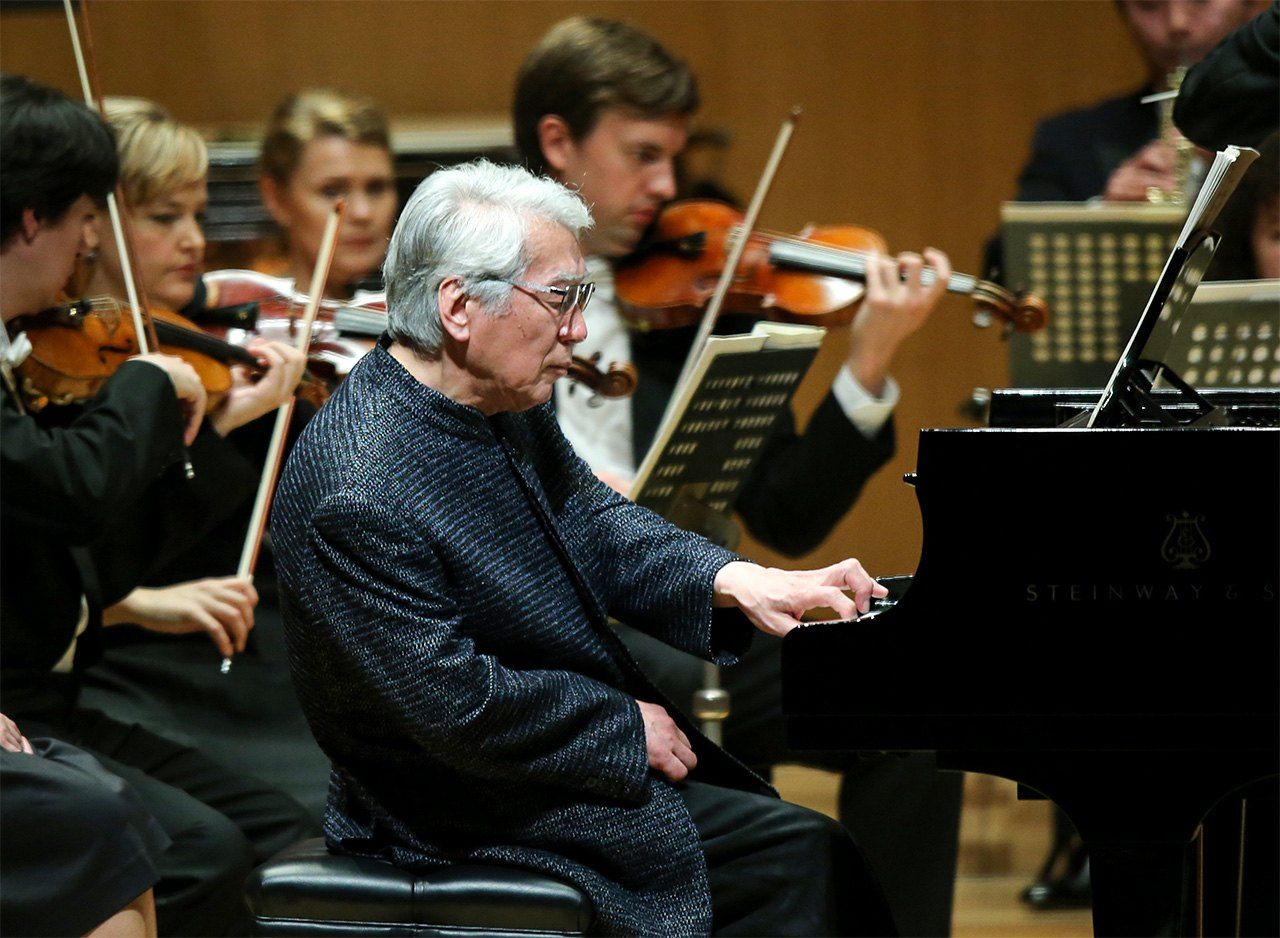
Performing on November 10, 2013, at Tokyo Opera City Concert Hall for the Izumi Tateno Festival, organized to celebrate Tateno’s seventy-seventh birthday. ©Jiji
Pioneering a New Genre
After his stroke, Tateno spent some time in rehabilitation, but soon realized he would never regain full use of his right hand. He was aware that there were works for left hand only, including Maurice Ravel’s Piano Concerto for the Left Hand, which he had previously performed. But the repertoire was limited in scope, and Tateno did not see it as the basis for a concert career. “I think I was waiting for some new inspiration,” he says.
That inspiration came from his eldest son Janne, a violinist. One day, Janne casually left a music score lying around where his father would see it. It was Three Improvisations for the Left Hand by British composer Frank Bridge. Bridge composed the piece in 1918 for a pianist who had lost his right hand in World War I.
“I thought for the first time, ‘Here’s the kind of music I could devote myself to.’ I realized that it was possible to achieve full artistic expression with the left hand only,” says Tateno.
Just two days later, Tateno commissioned a new composition from Mamiya Michio as the centerpiece of a comeback tour in Japan. Mamiya produced Wind Wrought—Offertorium (2004), a suite of five pieces inspired by Navajo myths centered on the wind god. The first keyboard work for left hand ever written by a Japanese composer, it posed considerable technical challenges, and the last piece was not completed until a few days before the tour was scheduled to begin, leaving Tateno with precious little time to practice. Needless to say, the concerts were a success and marked the start of his new career.
Determined to expand the left-handed piano repertoire, Tateno began commissioning works from composers in Japan and abroad. “At first, a lot of them were hesitant to take on the challenge,” he says. “But nowadays composers write pieces for me on their own initiative, without my asking.” In the realm of piano music, where it seems that everything has been done already, music for the left hand offers an opportunity for composers to distinguish themselves. “I’ve collected more than a hundred original works from composers spanning ten countries,” says Tateno. “And Japan is at the forefront of the trend.”
A few of these works, including Yoshimatsu Takashi’s Tapiola Visions, have become standards in Tateno’s repertoire. “Once I’ve performed something several dozen times, it becomes part of my being, and I can explore its expressive aspects more and more deeply. There’s something very rewarding about nurturing a piece of music to maturity in partnership with your audiences.”
There is no hint of inadequacy or frustration in Tateno’s one-handed playing. “From the start,” he says, “I felt nothing but happiness at being able to make music. I’ve never felt handicapped playing with my left hand only.” It is only recently that Tateno has begun to think of piano music for the left hand as posing special technical difficulties. “That’s because the music has evolved, and the pieces themselves are becoming more challenging to play. But that’s part of what makes it worthwhile.”
Tateno’s recent work also includes activities aimed at nurturing young artists with dystonia and other ailments affecting the right hand. In November 2018, he judged a competition for one-handed pianists in Kanazawa, Ishikawa Prefecture. The top two contestants performed at the Kanazawa music festival in May this year. Another competition will be held in November.
Playing Three-Handed with the Empress Emerita
Tateno credits music with opening the door to personal relationships that have enriched his life immeasurably. Among these is his friendship with the emperor emeritus and empress emerita of Japan. Tateno met the imperial couple back in 1983, when they visited Finland as Crown Prince Akihito and Crown Princess Michiko, and they have been friends ever since. Tateno has a special relationship with Empress Emerita Michiko, a devoted music lover and a pianist in her own right.
In 1993, after Michiko temporarily lost the use of her voice, the royal couple invited Tateno to Akasaka Palace, where he performed several pieces. On that occasion, Michiko also took a turn at the piano, playing “The Spruce” by famed Finnish composer Jean Sibelius (from his suite The Trees). Shortly after Tateno returned to the concert circuit, he and Michiko performed a piece for three hands at the Finnish embassy in Tokyo. The empress emerita has also been a regular attendee at Tateno’s “birthday concerts,” held each November in Tokyo.
“One time recently—I think maybe it was the year before last—her majesty was unable to come, so she called me on the phone, and she said to me, ‘Let’s play together again soon.’ She’s a person who always keeps her word, so I asked Yoshimatsu if he could adapt a few works for that purpose, and now I have three wonderful pieces for three hands that we can play together on the piano. The empress emerita recently underwent surgery, so I’m not sure when, but I’m hoping it will be sometime soon.”
The program for the 2019 birthday concert will feature a piece by Yoshimatsu, as well as world premieres by Finnish composer Kalevi Haho and Argentine composer Pablo Escande. For the Mysterium by Escande, Tateno will be joined by a string quartet, including his son Janne on violin.
“In 2020, I’ll be celebrating the sixtieth anniversary of my debut,” says Tateno. “So I’m thinking of doing an all-solo concert. Of course, there will be at least one world premiere. I’m already looking forward to it.” Tateno has never been one to look back.
(Originally published in Japanese based on an interview by Itakura Kimie of Nippon.com. Photos by Ōkubo Keizō except where otherwise noted.)
